
"It's time to come together"
Ares tiene la necesidad constante e imperiosa de crear, la capacidad (cuasi) infinita de trabajar. Por eso suele despertar en medio de la madrugada y no pierde tiempo intentado conciliar el sueño, sube a su estudio y da continuidad a cualquiera de las tareas que haya dejado horas antes inconclusas. Y así, muchas veces lo sorprende el amanecer dibujando, pintando, boceteando, escribiendo, leyendo, buscando información. Ni premios, ni reconocimientos o halagos lo engatusan. En lo que se refiere a la creación, pareciera que su sino estuviese resumido en los versos de una las canciones más conocidas de los Rolling Stone I can't get no satisfaction / 'Cause I try, and I try, and I try, and I try…
Las piezas que presenta en esta ocasión no son solo una parte de su producción más reciente si no, sobre todo, un resumen de sus preocupaciones y también el resultado del constante proceso de búsqueda y reflexión acerca de su identidad, acerca de la historia que le condiciona y que ha determinado la configuración geopolítica actual del orbe.
Los dibujos de humor se centran en esta ocasión en los procesos de conquista y colonización, pero no vistos desde la frialdad de los textos empolvados y distantes. Ares nos propone revisar la historia y cuestiona los relatos occidentales hegemónicos y civilizatorios: una catedral deviene bola de demolición ante una pirámide -y la cultura- maya, el traje de la reina María Cristina lleva como ornamento los barcos esclavistas negreros mientras la tristemente conocida “niña de napalm” huye de las carabelas y una mujer indígena carga sobre sus espaldas las consecuencias de lo que significó la llegada de estas embarcaciones a Nuestra América.
A Ares le duele esa historia, como diría Cortázar en Rayuela sobre uno de sus personajes, “le duele el mundo”. Le interesa también poner de relieve los episodios que se omiten en los macrorelatos épicos, tal vez por ello hay tantas mujeres como protagonistas de las obras de esta muestra. Se apropia del beso, recurrentemente enaltecido en la iconografía del arte occidental bajo el manto del machismo y la dominación romantizados, para visibilizar la experiencia de mujeres violentadas de las que poco o nada se conoce. Nos propone una mirada al pasado que trae implícita el cuestionamiento del presente, por eso aparecen aztecas indocumentados y sujetos culturales sometidos que no logran respirar. Es por ellos que no logra dormir…Nacido en 1963, es parte de lo que Juan Padrón llamó Nikita chama boom[1]. Creció escuchando en la radio de su casa a la Aragón y en la voz de su padre (que no era cantante) la trova tradicional cubana, en los carnavales el Bacalao con pan de Irakere y el Guararey de Pastora de Van Van, mientras en sus fiestas de adolescente alternaban la salsa de Oscar de León y Rubén Blades con Kiss y Grand Funk Railroad. Se asume mestizo no solo porque lo muestre su piel o porque lo sean también sus raíces familiares (madre y padre mulatos), sino porque se sabe y siente heredero y parte de la cultura cubana (también mestiza) y de eso que llaman “cultura universal” que carece absolutamente de pureza y en la que descubre constantemente nexos, huellas entre las expresiones de una latitud y otra del planeta.
Coexistió desde siempre, y de manera natural, con la heterogeneidad de interacciones sociales que supone vivir en el centro de Centro Habana, el municipio de mayor densidad poblacional de Cuba y probablemente también el demográficamente más diverso. Sus coordenadas urbanas pueden definirse entre el Sagrado Corazón de Jesús y el Gran Templo Nacional Masónico, entre el sitio que acogió el cuerpo moribundo de Yarini y aquel en el que se velaron las cenizas de Julio Antonio Mella. Donde, bien temprano en la mañana, se escuchan las campanadas de la iglesia de la Caridad a la par de las maracas y las campanitas que anuncian la moyugba. Un contexto que marca su espiritualidad.
Ares es ateo, pero reconoce y se conmueve con las expresiones culturales auténticas que son parte de las religiosidades. Se deja seducir por los imaginarios de las culturas originarias africanas y americanas; se apropia de ellos -a veces con guiños humorísticos- y los recontextualiza en el escenario contemporáneo del fútbol y la internet. Volvió una y otra vez sobre los egúngúnes bahianos impresionado por la cercanía con lo ancestral y por la riqueza visual, la fuerza y la cadencia de sus movimientos. Pintó a las vírgenes -otra vez las mujeres- con rostro inca, rostro tupinambá, rostro negro; les ofreció los girasoles de Van Gogh, les colocó el pecho una aldaba y como manto un chaleco salvavidas: ellas representan procesos de resistencia cultural.
Son también expresión de resistencia y resiliencia el azabache, la peonía y los ojos de Santa Lucía prendidos en la bandera y un escudo-aldabón; símbolos de protección, de esperanza, accesibilidad y cercanía. Porque Ares es un optimista impenitente. La mirada atenta y crítica a cuanto encuentra a su paso no le impide soñar una Cuba mejor, un mundo mejor. Por eso, con el mismo entusiasmo que canta I can't get no satisfaction… baila “el cuadrado” rodeado por su familia y sus amigos mientras canta de viva voz a ritmo de Kool & de Gang en su azotea de Centro Habana: It's time to come together / It's up to you, what's your pleasure? / (Everyone around the world, come on!) / Yahoo! / It's a celebration…
[1] Short cartoon film written and directed by Juan Padrón, produced by the ICAIC Animation Studios, about the October Crisis of 1962. It is dedicated to all Cubans born in 1963.

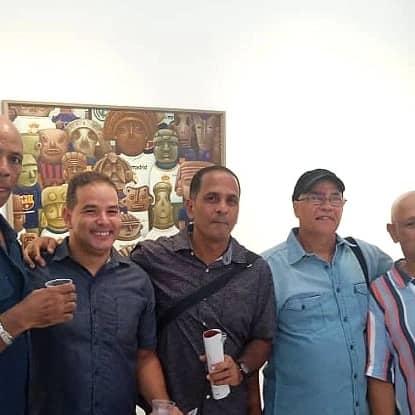
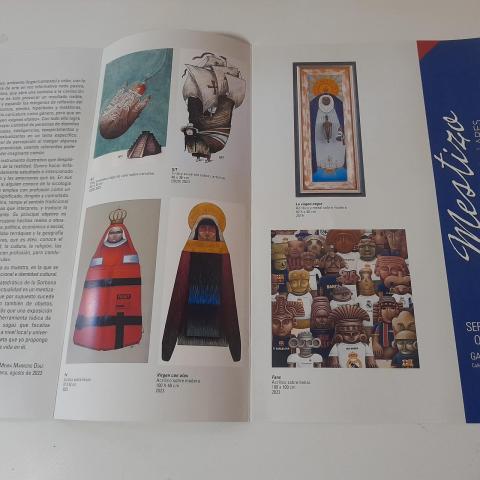
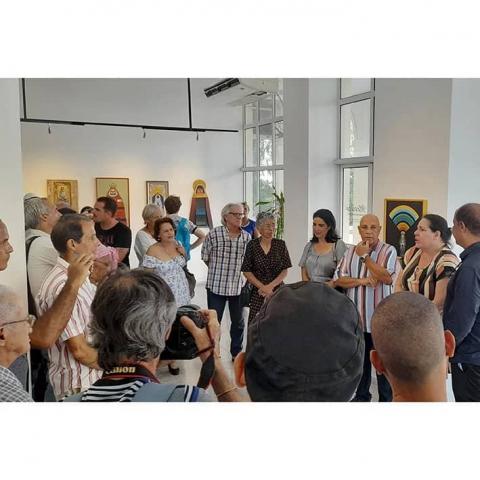
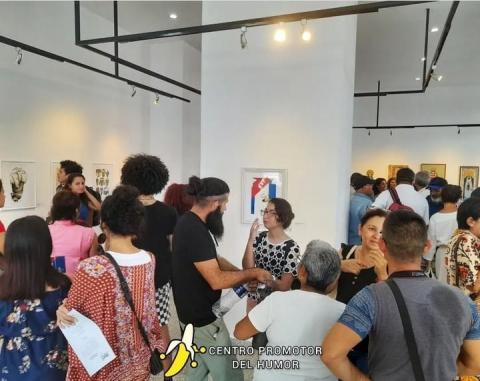
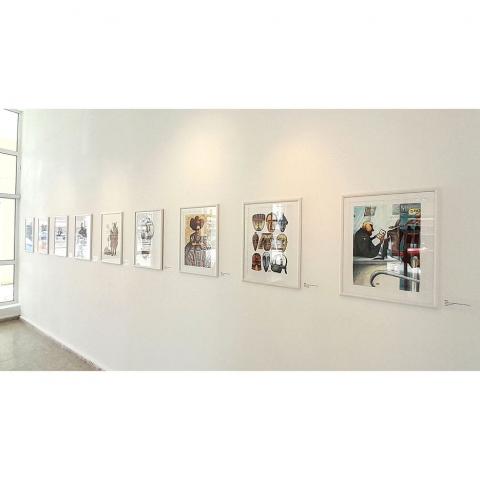
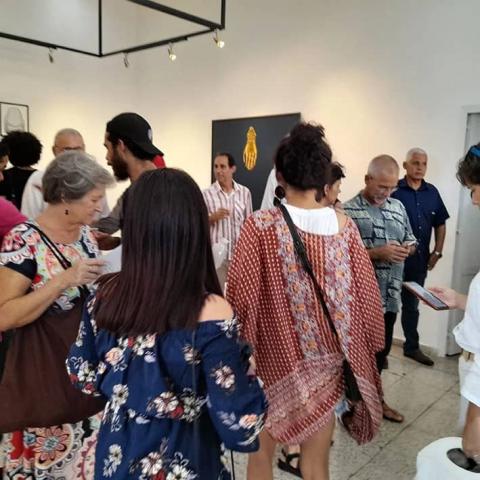
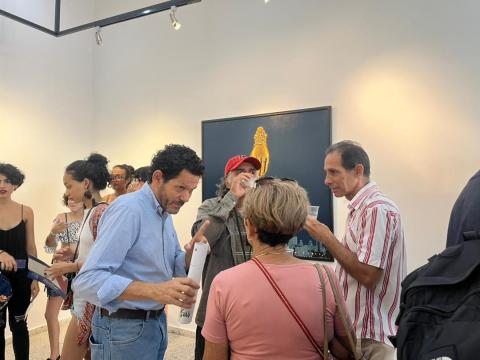
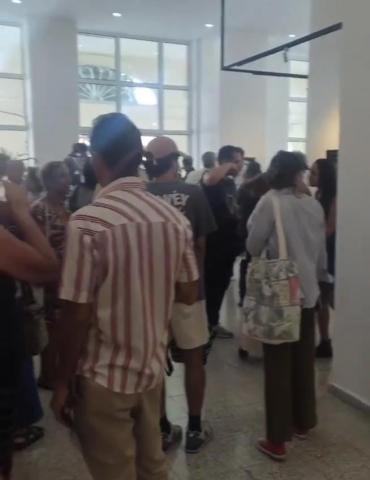
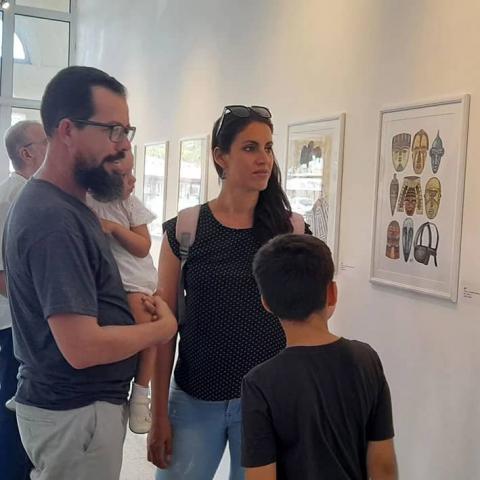
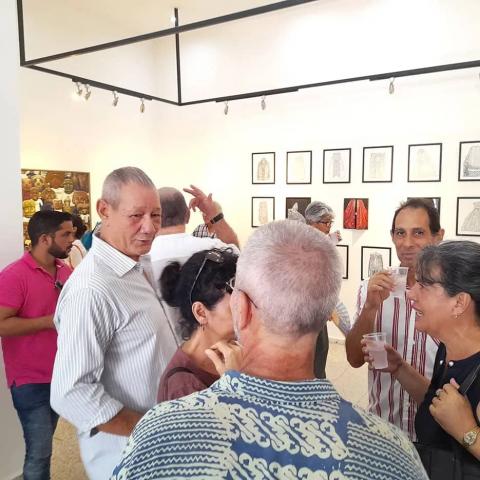
“It's time to come together”
Ares has the constant and imperative need to create, the (quasi) infinite capacity to work. That's why he usually wakes up in the middle of the morning and wastes no time trying to fall asleep; he goes up to his study and continues any of the tasks he left unfinished hours before. And so, many times the dawn surprises him drawing, painting, sketching, writing, reading, searching for information. Neither awards, recognition or praise cajole him. As far as creation is concerned, it seems that his fate was summed up in the verses of one of the best-known Rolling Stone songs I can't get no satisfaction / 'Cause I try, and I try, and I try, and I try…
The pieces he presents on this occasion are not only a part of his most recent production but, above all, a summary of his concerns and also the result of the constant process of search and reflection about his identity, about the history that conditions and has determined the current geopolitical configuration of the world.
The humorous drawings focus on this occasion on the processes of conquest and colonization, but not seen from the coldness of dusty and distant texts. Ares proposes that we review history and question hegemonic and civilizational Western narratives: a cathedral becomes a wrecking ball before a Mayan pyramid -and culture-, Queen María Cristina's costume is adorned with slave slave ships while the sadly known " napalm girl” flees from the caravels and an indigenous woman carries on her back the consequences of what the arrival of these vessels to Our America meant.
That story hurts Ares, as Cortazar would say in Hopscotch about one of his characters, “the world hurts him.” She is also interested in highlighting the episodes that are omitted in the epic macro-stories, perhaps that is why there are so many women as protagonists of the works in this exhibition. It appropriates the kiss, recurrently exalted in the iconography of Western art under the mantle of romanticized machismo and domination, to make visible the experience of violated women about whom little or nothing is known. It offers us a look at the past that implies the questioning of the present, which is why undocumented Aztecs and subjugated cultural subjects who cannot breathe appear. It is because of them that he cannot sleep...Born in 1963, he is part of what Juan Padrón called Nikita chama boom[1]. He grew up listening to traditional Cuban trova on the radio in his home, a la Aragón, and in the voice of his father (who was not a singer). Teenage parties alternated the salsa of Oscar de León and Rubén Blades with Kiss and Grand Funk Railroad. He assumes himself to be mestizo not only because his skin shows it or because his family roots (mulatto mother and father) are also mestizo, but because he knows and feels heir and part of Cuban culture (also mestizo) and of what they call “universal culture.” ” which absolutely lacks purity and in which it constantly discovers links, traces between the expressions of one latitude and another of the planet.
It has always coexisted, and naturally, with the heterogeneity of social interactions that comes with living in the center of Centro Habana, the municipality with the highest population density in Cuba and probably also the most demographically diverse. Its urban coordinates can be defined between the Sacred Heart of Jesus and the Great National Masonic Temple, between the site that housed Yarini's dying body and the one where the ashes of Julio Antonio Mella were buried. Where, very early in the morning, the bells of the Church of La Caridad can be heard along with the maracas and the bells that announce the moyugba. A context that marks their spirituality.
Ares is an atheist, but he recognizes and is moved by the authentic cultural expressions that are part of religiosities. He allows himself to be seduced by the imaginaries of the original African and American cultures; he appropriates them -sometimes with humorous winks- and recontextualizes them in the contemporary scenario of football and the internet. He returned time and again to the Bahian egunguns, impressed by their proximity to the ancestral and by the visual richness, strength and cadence of their movements. He painted the virgins - again the women - with Inca faces, Tupinambá faces, black faces; He offered them Van Gogh's sunflowers, placed a knocker on their chests and a life jacket as a cloak: they represent processes of cultural resistance.
The jet, the peony and the eyes of Saint Lucia attached to the flag and a shield-knocker are also an expression of resistance and resilience; symbols of protection, hope, accessibility and closeness. Because Ares is an unrepentant optimist. The attentive and critical look at everything he finds in his path does not prevent him from dreaming of a better Cuba, a better world. Therefore, with the same enthusiasm that he sings I can't get no satisfaction... he dances “the square” surrounded by his family and friends while he sings out loud to the rhythm of Kool & de Gang on his rooftop in Centro Habana: It's time to come together / It's up to you, what's your pleasure? / (Everyone around the world, come on!) / Yahoo! / It's a celebration…
[1] Cartoon short film written and directed by Juan Padrón, produced by the ICAIC Animation Studios, about the October Crisis of 1962. It is dedicated to all Cubans born in 1963.
(This text has been translated into English by Google Translate)
